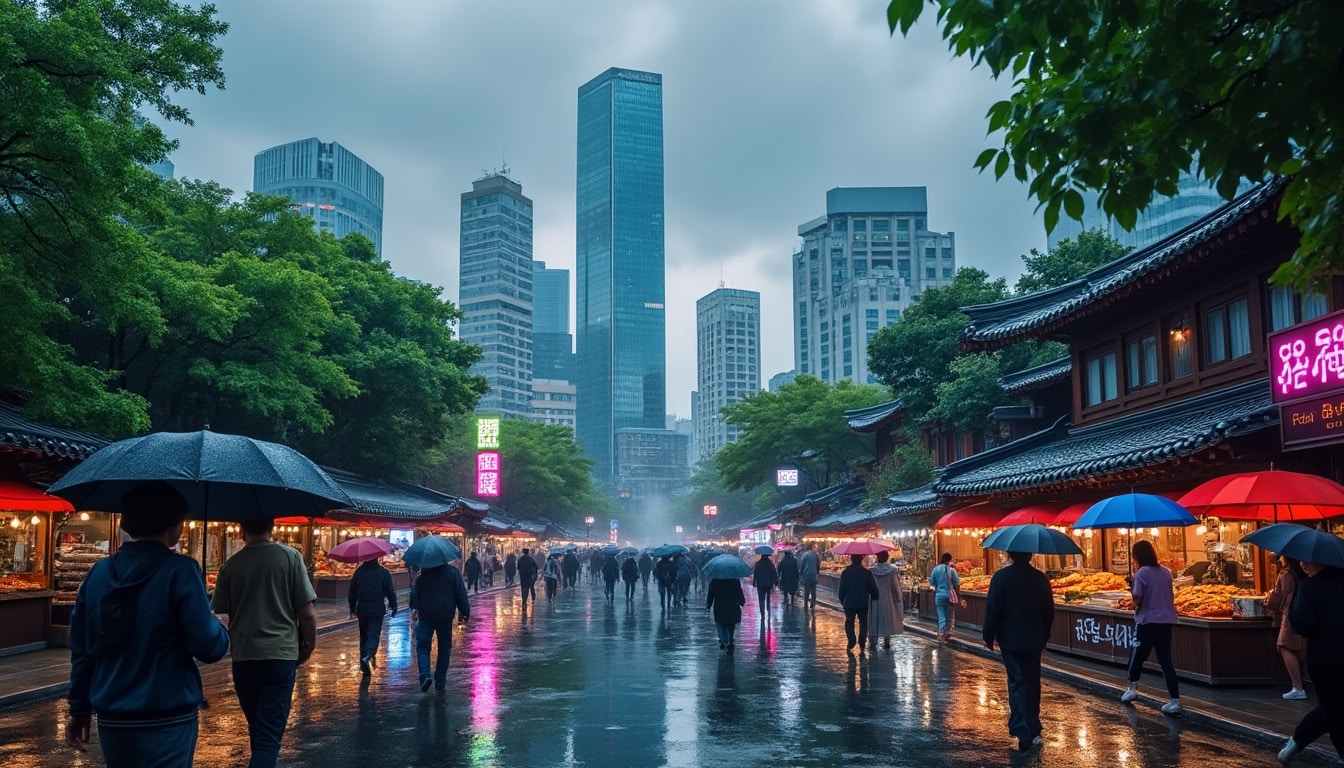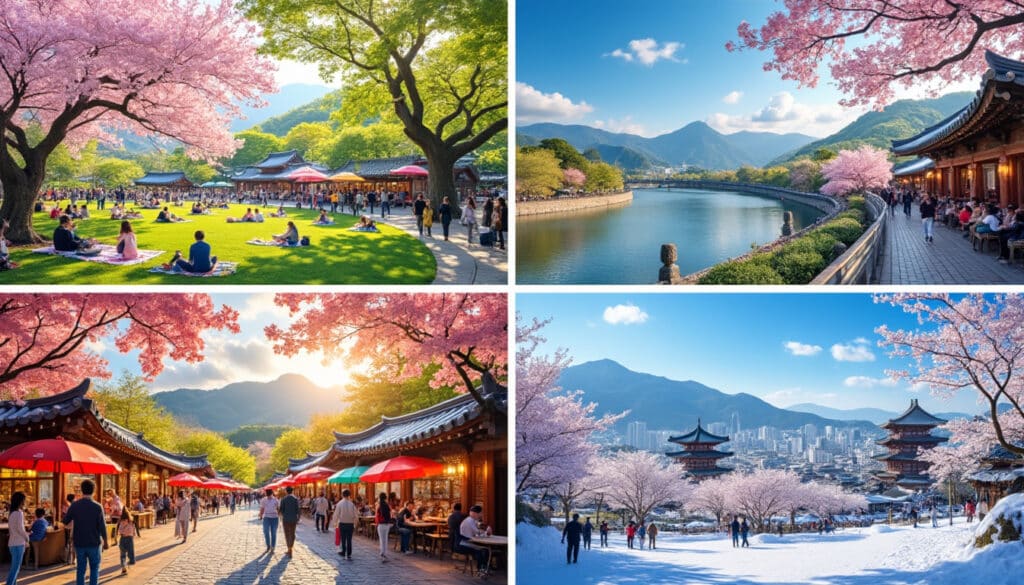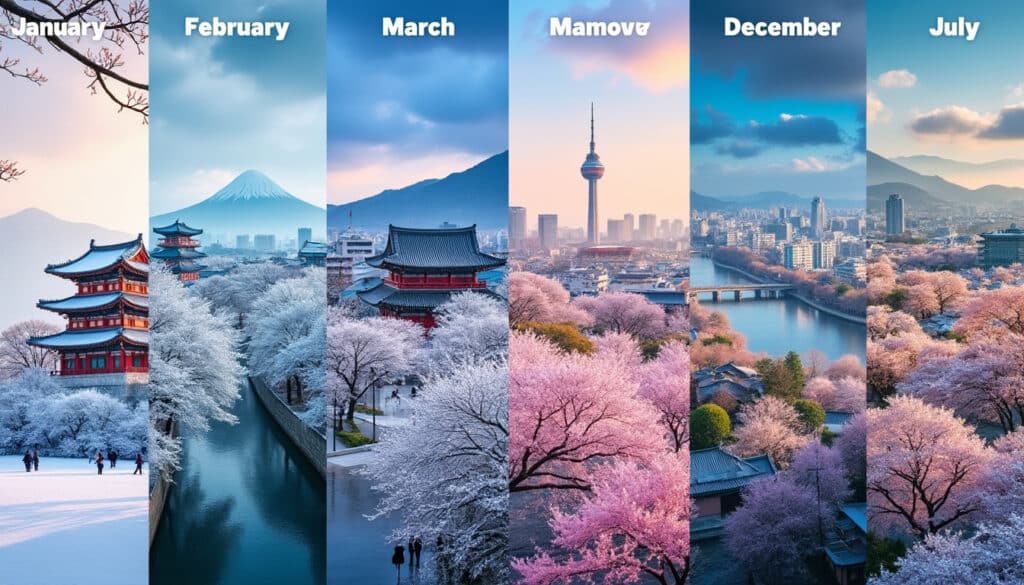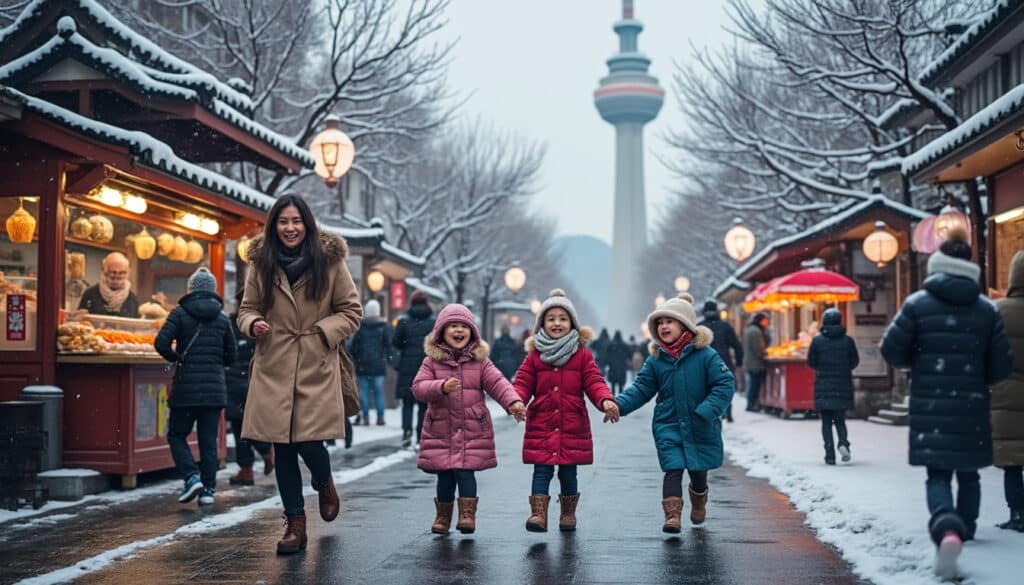When one thinks of Seoul, the vibrant capital of South Korea, they might envision bustling streets, cutting-edge technology, and a rich blend of modern and traditional culture. However, nestled within these urban delights is a lesser-discussed yet crucial aspect: the climate. Particularly notable is Seoul’s humidity, a factor that influences not just the daily life of its residents, but also impacts visitors’ experiences. Understanding the nuances of humidity in this city is key to planning a visit or simply savoring what Seoul has to offer.
Understanding Seoul’s Humidity Levels
Seoul’s climate is both unique and varied, characterized by its four distinct seasons. This seasonal variation significantly affects the city’s humidity levels. With average relative humidity ranging from 62% in the drier months to a sweltering 81% during the peak of summer in July, understanding this aspect of the climate can enrich one’s experience in the city.
The summer months, from June to August, bring the highest levels of humidity due to the monsoonal rains. The bright and sunny days of May, which record approximately eight hours of visible sunshine, gradually give way to heavier precipitation and overcast skies. By July, with an average precipitation of 144.5 mm and 14 rain days, the atmosphere becomes notably humid. Residents and visitors often find themselves relying on air conditioning to escape the oppressive heat.
Conversely, the winter months present a much drier climate. January and February mark this period, with the lowest recorded humidity levels at around 62-64%. The crisp cold air, coupled with a mere 0.6 mm of precipitation in January, offers a stark contrast to the muggy atmosphere of the summer.
Let’s delve deeper into what these numbers mean for daily life in Seoul. In summer, the “Humidex” or humidity index, often exceeds comfort levels, affecting how temperatures are felt. For example, even if the mercury reads a comfortable 25°C, the high levels of moisture can make it feel considerably warmer. This leads to people wearing lighter fabrics like linen or opting for airy attire to combat the sticky conditions.
In response to these climatic conditions, South Korean companies like Samsung and LG have developed advanced HVAC technologies and air purifiers, ensuring buildings and homes in Seoul can provide respite from both the cold and humid extremes. Furthermore, understanding these climatic factors can heavily influence travel plans, dictating the best times to explore the city’s outdoor attractions or to indulge in retail therapy at Lotte or Shinsegae malls.
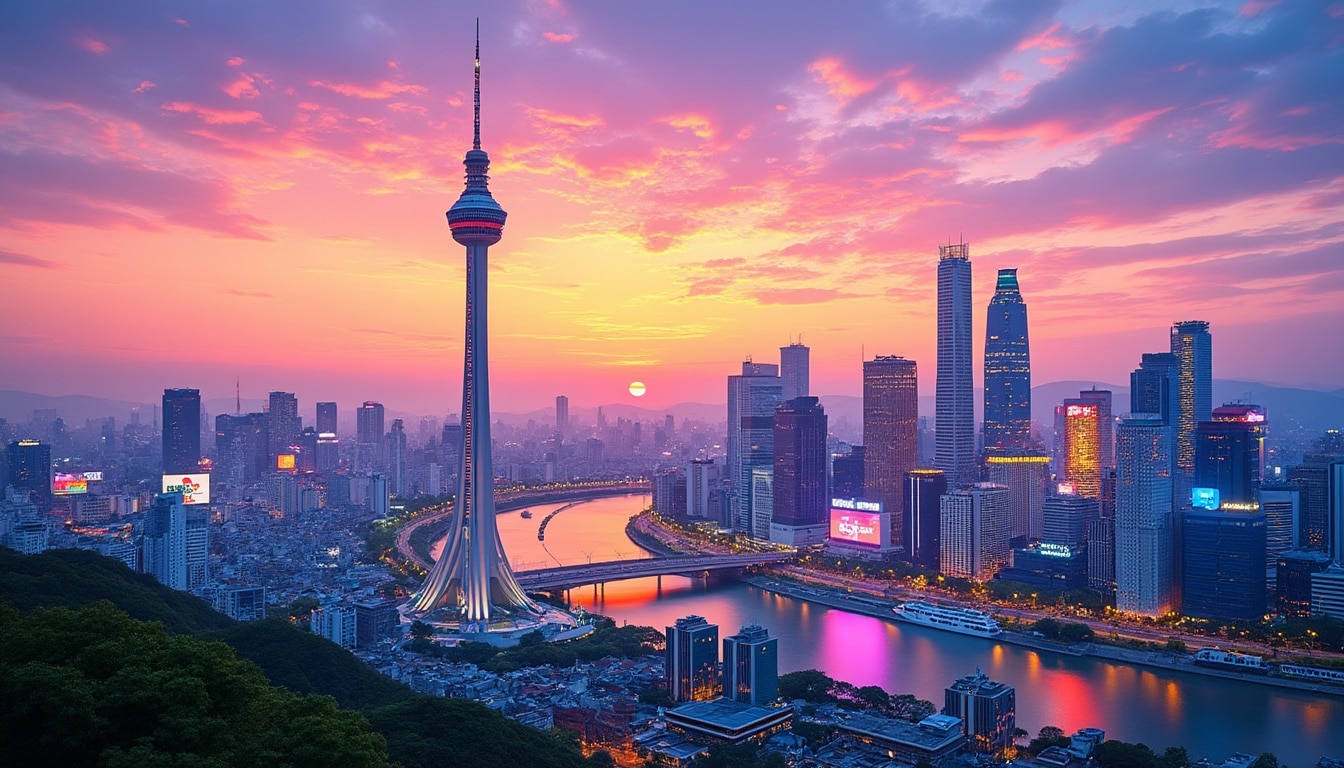
Thus, grasping the intricacies of humidity in Seoul not only prepares one for a more comfortable visit but also provides insight into how the city’s daily rhythm adapts to its climate. As we move forward, exploring each season’s unique characteristics offers a comprehensive picture of what to expect and how to navigate Seoul effectively.
Spring in Seoul: A Breath of Fresh Air
Spring in Seoul is a season that captivates both locals and tourists alike. As the cold grip of winter ebbs away, February marks the beginning of rising temperatures, which continue to increase through March and April. During this time, the humidity remains relatively moderate, ranging around 62%. The combination of mild temperatures and clear skies makes spring one of the most pleasant times to experience Seoul, avoided by the heavy humidity of the upcoming summer months.
One of the most celebrated phenomena during this period is the blooming of cherry blossoms, typically occurring between late March and early April. The blossoms not only enhance the beauty of the city but also symbolize new beginnings, aligning perfectly with the life cycle and renewal themes of spring. In parks such as Yeouido Hangang and Namsan, the cherry blossoms draw large crowds for hanami, or flower viewing, a tradition that encourages relaxation amidst nature’s splendor.
Beyond the aesthetics, this season offers a variety of events and festivals. For example, the Seoul Street Arts Festival transforms public spaces into vibrant stages, celebrating creativity and pushing cultural boundaries. The festival’s timing in April, when the weather is ideal and the views are clear, invites residents and tourists alike to enjoy performances in an atmosphere free from extreme humidity.
Spring’s temperate climate also encourages outdoor exploration. The air is fresh and clean, providing the perfect opportunity to enjoy Seoul’s hiking trails, such as those in Bukhansan National Park. These excursions allow for a deeper connection with South Korea’s natural landscapes, far removed from the heat-intensive urban setting.
Complementing physical comfort, spring is a season where Seoul’s culinary scene flourishes. Local markets like Gwangjang Market brim with seasonal produce such as cherry blossoms and strawberries, which influence traditional dishes and snacks. These culinary delights offer a refreshing change from the heavier, comfort foods typically consumed during the colder months.
It is during spring when firms such as AmorePacific, renowned for innovative skincare solutions, introduce products designed to protect against the changing climate while capitalizing on the skin renewal processes typical of this season.
In summary, spring in Seoul is a time of rejuvenation and exploration, a counterpart to the more extreme summer conditions that follow. The reduced humidity levels paired with longer daylight hours allow for both the city and its natural surroundings to be enjoyed in comfort. The vibrancy of this season lies not only in its natural phenomena but also in its cultural vivacity, ensuring numerous opportunities to experience Seoul in an atmosphere of perfect equilibrium.
As spring fades and summer dawns, the city’s dynamic adaptability to changing climate conditions becomes even more apparent, characterizing Seoul as a destination of everlasting intrigue and variety.
Summer: Navigating Seoul’s Humid Embrace
Summer in Seoul transforms the city into a humid embrace, with monsoons marking a period of intense precipitation and elevated humidity. Generally commencing in June and lasting until August, the summer months witness the highest levels of moisture. July particularly stands out with an average humidity of 81% and a hefty rainfall of approximately 144.5 mm, making it the wettest and most uncomfortable time of the year for humidity-sensitive visitors.
This season’s high humidity creates a unique set of challenges for city dwellers. The muggy air can saturate clothing, increase fatigue, and elevate the perceived temperature, often leading to feelings of discomfort and lethargy. Fortunately, advancements in technology, led by companies like Hyundai and SK Telecom, have brought innovative climate control solutions, ranging from sophisticated vehicles with air quality management systems to smart home devices that regulate indoor environments efficiently.
Despite these challenges, summer in Seoul is not without its charm. The vibrancy of nature remains evident in lush green parks and the blooms in areas like the Seoul Forest, offering a haven amidst the heat. Meanwhile, numerous indoor attractions, such as museums and shopping centers like Naver and Lotte World, offer air-conditioned escapes for those looking to avoid the stifling humid air.
For those brave enough to venture outdoors during this season, wearing moisture-wicking fabrics, carrying portable fans, and staying hydrated are critical. Additionally, mastering the art of navigating Seoul’s efficient public transportation system can significantly reduce one’s exposure to the sticky heat.
Here’s a checklist for survival during the Seoul summer: 🌞
- ⚠️ Dress in light, breathable clothing
- 💧 Stay hydrated to combat dehydration
- 🧢 Use hats and sunglasses for sun protection
- 🚆 Utilize shaded or air-conditioned transit options
- 🏝️ Plan visits to air-conditioned attractions or cool outdoor spots
Embracing local customs also offers a fascinating way to cope with the challenging climate. Consumption of cold noodles and other cooling foods rejuvenates the body during sweltering days. Furthermore, water-filled shopping complexes and cultural festivals provide entertainment options to enjoy in a cooler, regulated environment.
The embrace of technology and culture allows Seoul to thrive even in the muggiest of conditions. Coupang, South Korea’s rapidly growing e-commerce company, facilitates the fight against summer discomfort by providing access to an array of summer essentials conveniently delivered to your doorstep.
Ultimately, summer in Seoul embodies both challenge and innovation. While the humidity is a tangible presence, it also forms a backdrop for urban ingenuity and resilience. As such, it becomes a season not solely defined by stifling air but by the spirited adaptations it inspires, turning humid hurdles into channels for creativity and life.
Autumn’s Respite: Seoul’s Cooling Embrace
Transitioning from the humid grip of summer, autumn in Seoul emerges as an idyllic time marked by vivid foliage and a noticeable dip in humidity levels. Stretching from September through November, autumn paints the city in warm hues of red, orange, and gold, offering a picturesque backdrop to an otherwise bustling urban scape.
September marks the gradual decline of humidity, with levels dropping to a more moderate 75%. This reduction breathes a sigh of relief over the city, allowing both residents and tourists to explore with newfound comfort. By October, humidity stabilizes at around 71%, with temperatures dipping into the pleasant range of 20°C. The cooler air provides perfect conditions for outdoor activities, drawing citizens to Seoul’s myriad of parks, gardens, and mountains.
This season is revered for its optimal weather, making it prime time for traveling. The pleasant atmosphere enhances the experience of tourist hotspots like the Gyeongbokgung Palace and Dongdaemun Design Plaza. Outdoor markets, such as the Insa-dong street market, come alive with seasonal produce, crafts, and snacks – a cultural tapestry that reflects South Korea’s vibrant heritage.
The Korean thanksgiving holiday, Chuseok, usually takes place in autumn, highlighting cultural unity and gratitude. It provides an excellent opportunity for visitors to learn about and participate in traditional family customs, sharing meals and stories in an atmosphere undisturbed by oppressive heat or rainfall.
The automotive giant Kia has been known to launch new vehicle models around this time, taking advantage of the pleasant weather to host open-air unveilings and test drives under the colorful foliage. Meanwhile, Shinsegae leverages the cool weather to promote outdoor shopping events that invite consumers to enjoy fresh goods and entertainment without weather-related discomfort.
To enhance your autumn experience, consider these activities: 🍂
- 🍁 Take a scenic hike at Bukhansan or Namsan Mountain
- 🎨 Explore cultural festivals celebrating art and history
- 🎑 Attend Chuseok festivities for a deeper cultural understanding
- 🚗 Visit car shows and outdoor events hosted by Kia and others
- 🍏 Enjoy the harvest festivals and sample Korean autumn cuisine
Through autumn, Seoul truly shines with its harmonious blend of natural beauty and cultural richness, capturing the hearts of those who wander through its streets and landscapes. It is a season of transformation, where the city’s aesthetic and climate collaborate to offer an experience of delightful tranquility and charm.
Winter Wonders: The Cold Warmer Side of Seoul
As autumn bids farewell, winter envelops Seoul in its cold embrace, offering a stark yet beautiful contrast to the preceding seasons. From December to February, the city experiences its coldest months, with temperatures often dipping below freezing. However, the chill is accompanied by low humidity levels, presenting a dry and crisp atmosphere that is generally tolerable for most visitors.
January, the coldest month, witnesses temperatures plummeting to an average low of -7°C, with humidity dwindling to 64%. The dry winter air offers clearer skies, presenting unobstructed views of Seoul’s skyline and surrounding mountains. This is an ideal time for those seeking a winter experience, complete with snow-dusted streets and traditional hot teas that offer a cozy warmth against the chill.
Even as the mercury drops, the city remains a hive of activity. Seasonal lights illuminate streets, transforming Seoul into a glittering wonderland of festivals and celebrations. Popular attractions during this time include the Seoul Lantern Festival and the Annual Winter Festival, which showcase the city’s festive spirit through illuminating displays and vibrant cultural performances.
For tech enthusiasts, winter also marks the launch of cutting-edge gadgets from Samsung and LG, perfect for showcasing innovations that offer warmth and connectivity during the cold months. These can range from advanced wearable tech to state-of-the-art heating appliances designed to keep the chill at bay.
An appealing winter custom in South Korea involves indulging in street foods such as hotteok (filled pancakes) and tteokbokki (spicy rice cakes), which provide a delightful contrast to the cold surroundings. Further, the Korean pastime of visiting hot springs and jjimjilbang (Korean spas) offers therapeutic warmth, allowing visitors to unwind and embrace the season’s coziness.
Adventure seekers can venture to nearby ski resorts or partake in unique winter sports. SK Telecom enhances these experiences through its excellent network connectivity, ensuring travelers remain connected and informed while navigating Seoul’s winter landscape.
Winter in Seoul isn’t merely about enduring the cold, but embracing the enchantment that comes with it. While the winds may bite, the warmth offered through festivals, foods, and cultural practices provides a unique charm that beckons adventurers to savor every moment.
While Seoul offers a diverse climate throughout the year, its humidity levels shape the city’s identity in intriguing ways. Whether planning a visit or simply diving into the richness of Seoul’s seasonal changes, understanding and embracing the local climate can enhance the journey, making each moment memorable and engaging.
FAQ: Understanding Humidity in Seoul
Q: What is the best time to visit Seoul for comfortable humidity levels?
A: The ideal time to visit Seoul, with moderate humidity and pleasant weather, is during the spring (April to June) and autumn (September to November) seasons.
Q: How does humidity affect daily life in Seoul?
A: High humidity in summer can make temperatures feel warmer, affecting comfort levels. Conversely, the low humidity in winter presents a dry, crisp atmosphere that some may find more comfortable.
Q: What are some tips to cope with Seoul’s humid summers?
A: To handle Seoul’s humid summers effectively, it is advisable to stay hydrated, wear breathable clothing, utilize air-conditioned establishments, and engage in indoor activities during the peak heat hours.
Q: Is there a place to escape the humidity in Seoul?
A: Yes, numerous museums, shopping centers like Lotte, and tech-friendly cafés offer respite with their efficient climate control systems. Additionally, Seoul’s comprehensive transit system ensures minimal exposure to the elements.
Q: Are there significant cultural activities linked to Seoul’s climate?
A: Yes, each season hosts distinct cultural festivals that align with the changing climate, such as the cherry blossom festivals in spring, Chuseok in autumn, and the Seoul Lantern Festival in winter.
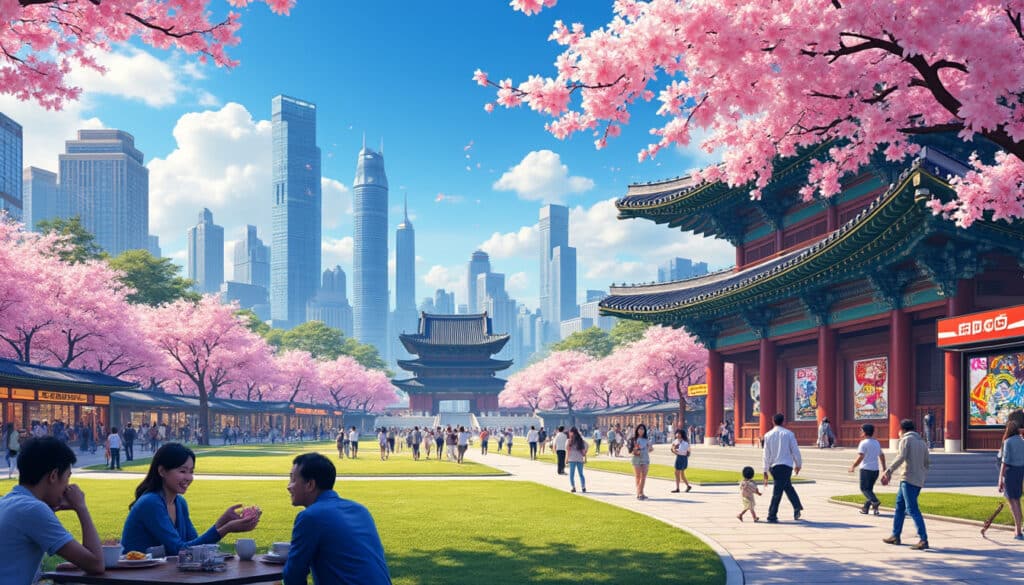
Seoul, the bustling heart of South Korea, boasts a climate as vibrant and varied as its cultural landscape. Visitors and residents alike are treated to four distinct seasons, each bringing its own flavor to the city. From the icy chills…
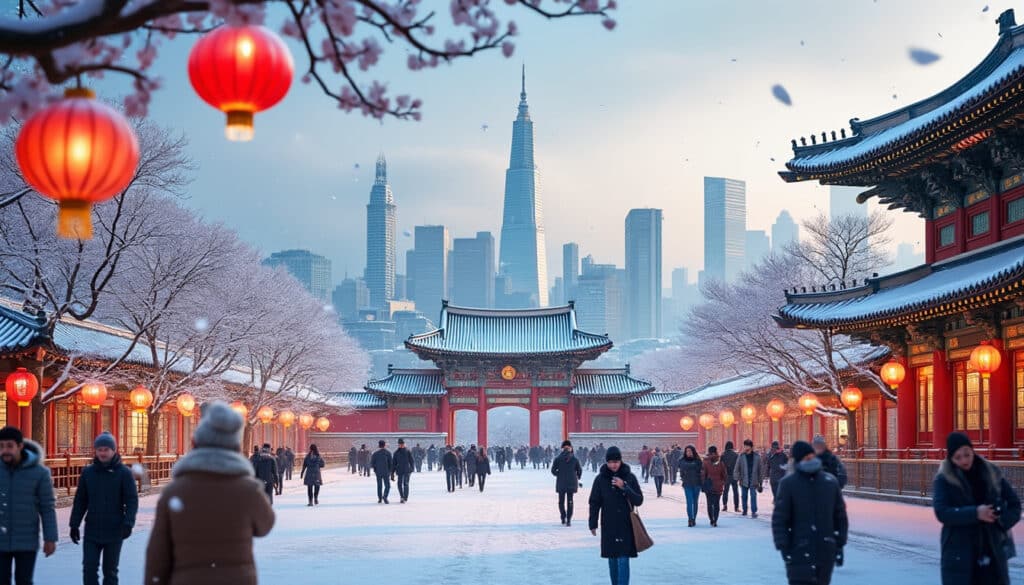
When imagining Seoul in winter, visions of snow-dusted palaces, serene parks, and bustling streets adorned in festive decorations might come to mind. But does it truly snow in Seoul? While South Korea’s capital city does experience winter weather, it doesn’t…

Flooding and natural risks in Seoul
Seoul, the bustling heart of Korea, is not without its challenges. As the city juggles rapid urbanization and meteoric technological advances, it also faces the formidable threats of flooding and other natural risks. Dubbed as one of the “Mega Cities”,…
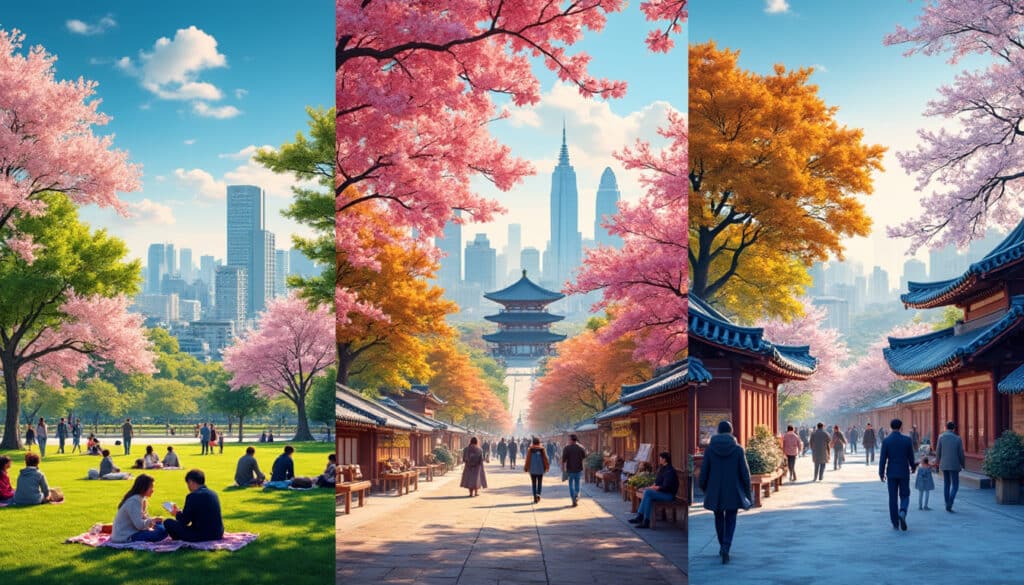
Is Seoul warm throughout the year?
Seoul, the dynamic capital of South Korea, is known for its rich culture and vibrant cityscape. Yet, it also presents a diverse climate that varies significantly across the year. Understanding Seoul’s weather patterns is essential for prospective travelers, businesses like…
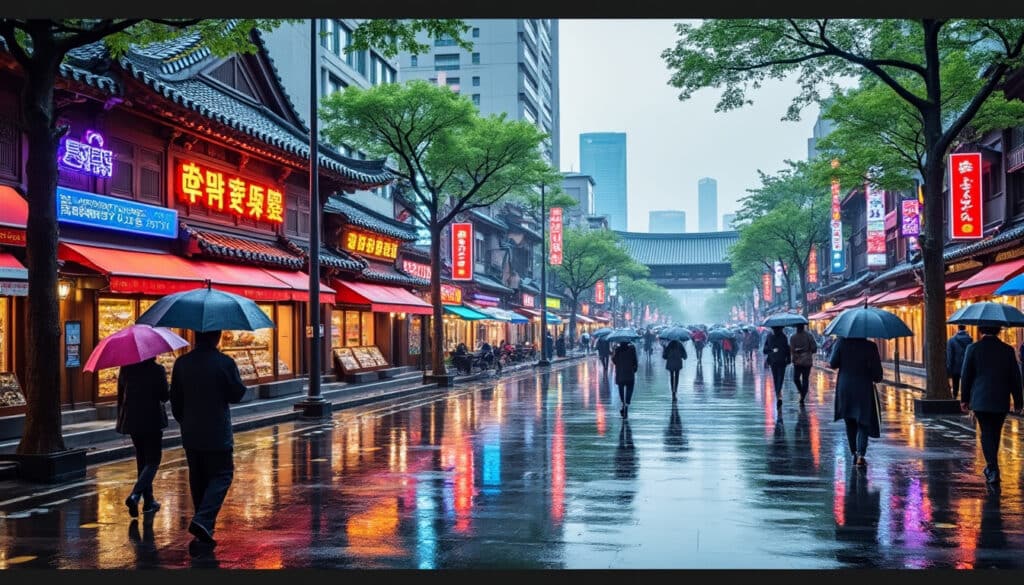
Rain and precipitation in Seoul
Seoul, the bustling heart of South Korea, is a city that experiences a wide array of weather patterns throughout the year. Its unique climate is characterized by hot, humid summers and cold, dry winters, influenced by its geographical location and…

Seoul, the vibrant capital of South Korea, presents a captivating blend of ancient traditions and bustling modernity. In this city where time seems to stand still and rush forward simultaneously, experiencing the beginning of a new day at sunrise is…
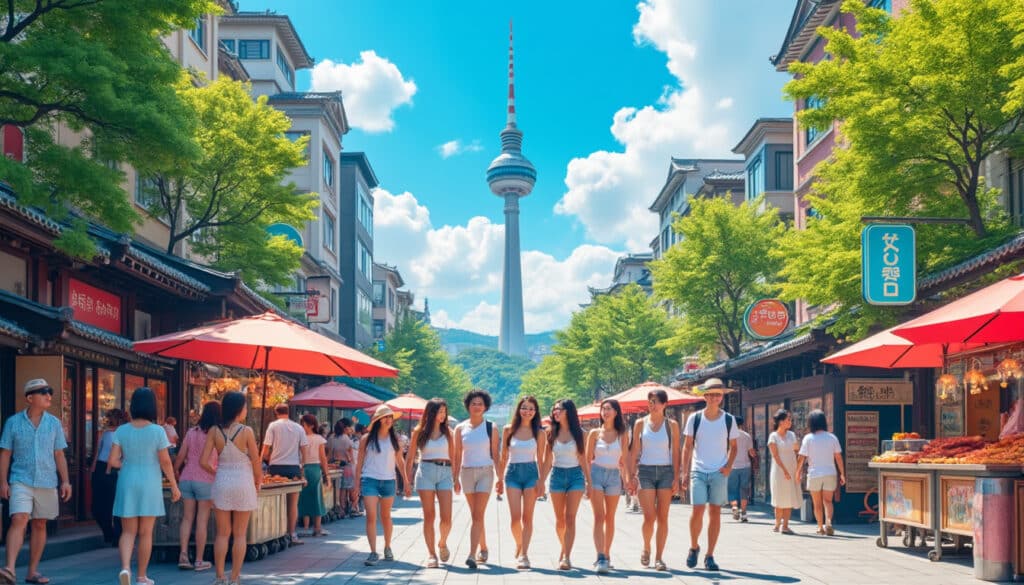
As the vibrant cityscape of Seoul continues to captivate travelers and residents alike, understanding its temperature trends becomes essential for planning visits and daily activities. The city, known for its unique blend of tradition and modernity, offers a distinct climate…
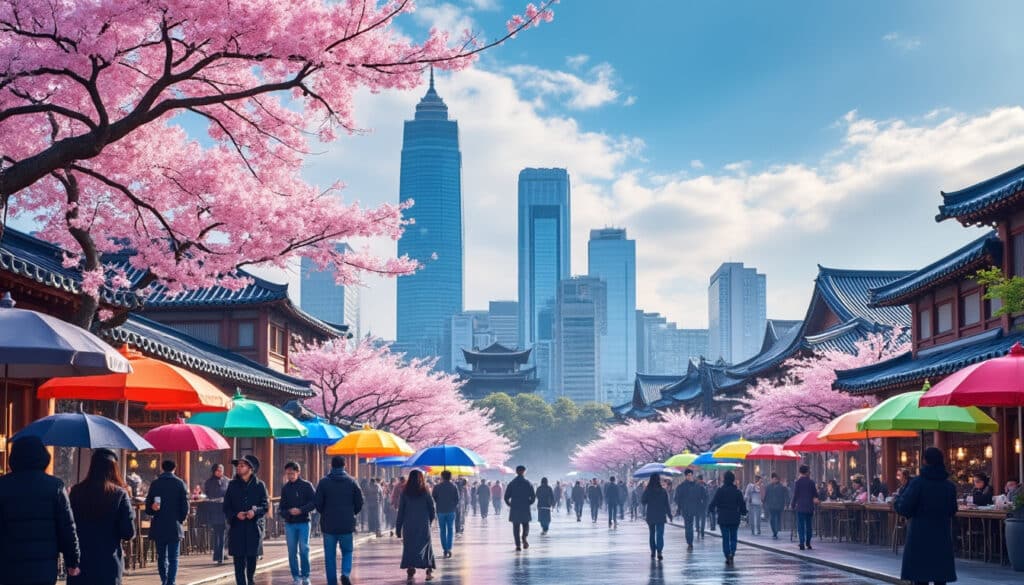
What is the weather like in Seoul?
Seoul, a bustling metropolis with a perfect blend of ancient traditions and modern innovations, often leaves its visitors and residents curious about its weather patterns. While the city is famous for its historic palaces, cutting-edge technology, and mouth-watering cuisine, understanding…
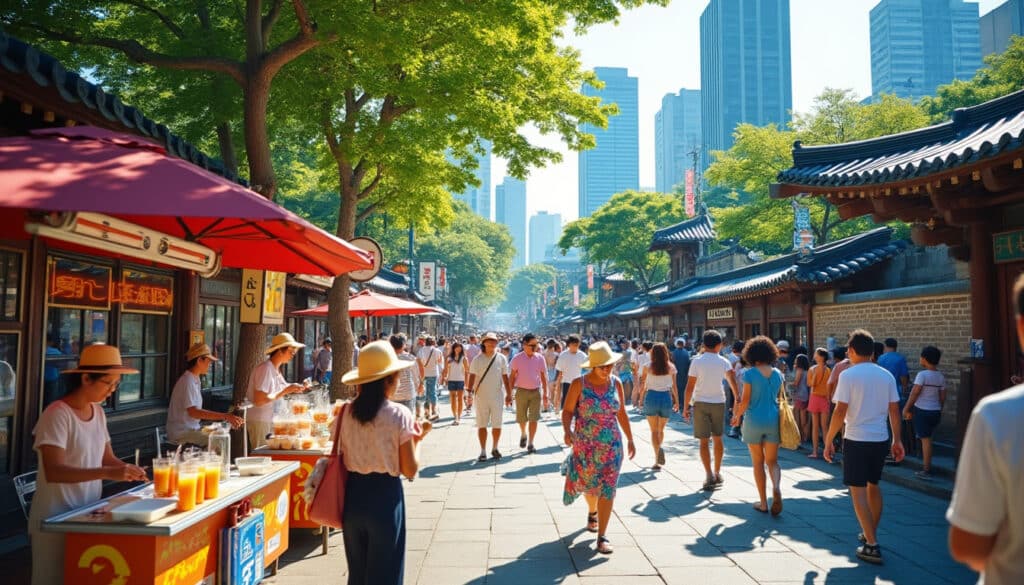
Seoul, a vibrant city known for its mix of traditional culture and modern innovation, transforms under the blazing summer sun. With its hot and humid climate, Seoul during summer is a true testament to the concept of endurance and adaptation.…

